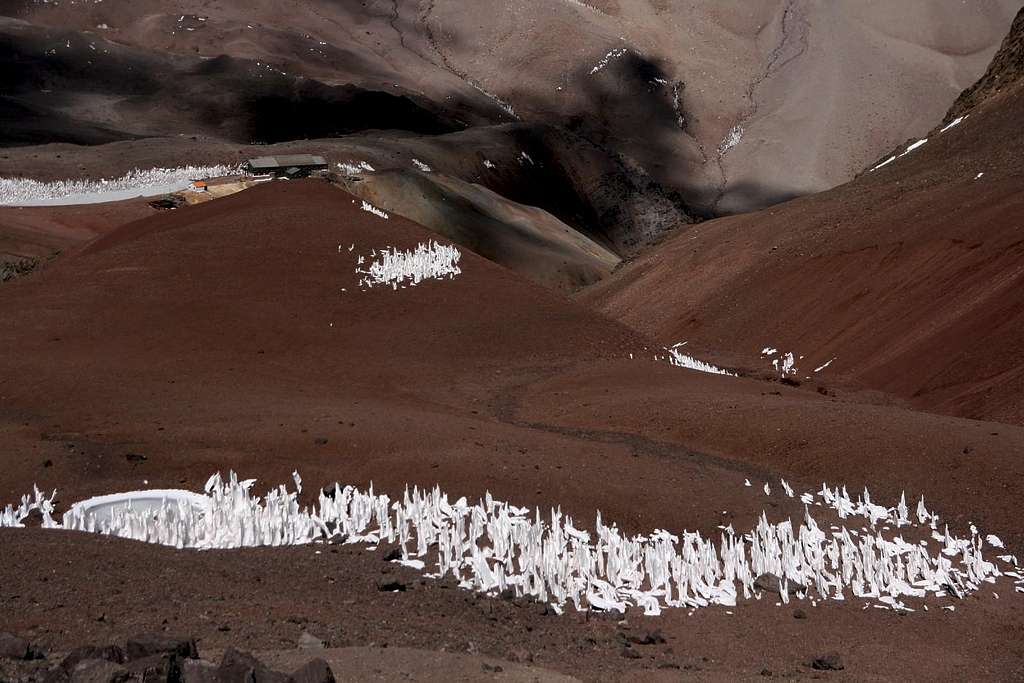delmarco - Mar 16, 2008 4:23 pm - Hasn't voted
Penitentes?What is that? how does it form?
delmarco - Mar 16, 2008 4:25 pm - Hasn't voted
Nevermind I found it...Spiked Ice
J. Corripio/ETH, Zurich
Reaching for the sun. Fields of spiky ice may help preserve glaciers. Now a team has created them in the lab.
A team of physicists has created the first artificial versions of spiky ice formations that naturally appear on high-altitude glaciers. Understanding their growth may give researchers insight into the process of glacier "evaporation" and may shed light on similarly-shaped micro-spikes that appear in materials like those in solar-powered energy cells, they report in the 10 March PRL. The team also suggests a possible way to use the formations to preserve glaciers in an era of global warming.
The spikes of snow or ice are called penitentes, and some can be 4 meters high. They are common on high-altitude glaciers, such as those in the Andes mountains, where the air is dry, and the sun's rays can turn ice directly into water vapor without melting it first--a process called sublimation. An initially smooth snow surface first develops depressions as some regions randomly sublimate faster than others. The curved surfaces then concentrate sunlight and speed up sublimation in the depressions, leaving the higher points behind as forests of towering spikes. At the micro-scale, similar-looking spikes help solar cell surfaces maximize their sunlight absorption.
To better understand how both types of formations grow, Vance Bergeron of Ecole Normale Supérieure in Paris and his colleagues made penitentes in their lab. After some false starts, the apparatus that worked was a large horizontal freezer with a clear Plexiglas top. The team cooled the air by sending it through liquid nitrogen and also controlled humidity. They shined a flood lamp onto a block of snow or ice in the freezer and produced one- to five-centimeter-tall spikes on the block within a few hours.
Surprisingly, penitentes grew at rates independent of the relative humidity, at least up to a humidity of 70%. Increasing temperature above -4 degrees Celsius, on the other hand, slowed their growth dramatically, so a rise in global temperatures could reduce their numbers, the team believes.
These tall spikes on glaciers cast the snow into shadow, which may slow the overall rate of sublimation compared with flatter regions. So a decrease in penitentes could accelerate the loss of glaciers, since they would lose this cooling mechanism, say Bergeron and his colleagues. Glacial meltwater runoff is essential for agriculture in central Chile and Argentina, so any loss of glaciers would be catastrophic for farmers, says geophysicist Javier Corripio of the Swiss Federal Institute of Technology (ETH) in Zurich.
The team found that a sprinkling of black carbon powder on a snow surface accelerated penitente growth because it shaded the peaks more effectively than the troughs. So a small amount of dirt could help preserve Andean glaciers, they write. But geophysicist Stephen Warren of the University of Washington in Seattle disagrees with some of the paper's assumptions. He says penitentes might also increase glacial melting as sunlight bounces around the spikes and heats them. He also says that sublimation is good for glaciers because it absorbs heat that might otherwise warm and melt much more ice. The heat balance for glaciers is a complex physics problem, according to Warren.
Corripio says the work will contribute to long-term glacier research. "We have a very poor knowledge of these remote regions of the Andes mountains," he says, "but these experiments will help us in identifying better monitoring tools and field observations."
--Margaret Putney
Margaret Putney is a freelance science writer in Oberlin, Ohio.
Mathias Zehring - Mar 16, 2008 4:49 pm - Hasn't voted
interesting article... and the longest comment I received ever to a picture ;-)









Comments
Post a Comment